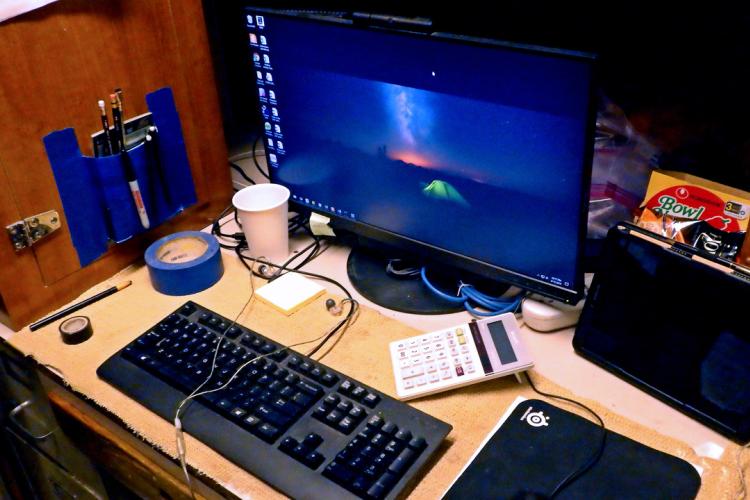It may seem perfectly reasonable to assume Newton’s First Law has got your back, but on a boat, this isn’t a reasonable assumption. This becomes very clear, the first time you set a full cup of piping hot coffee squarely down on your observer office desk, then right before your eyes, it launches into the air, dyeing your pristine data forms to the color of an ancient pirate treasure map. You quickly realize that living on a boat means changing your expectations or at least changing your daily routine around the fact that everything moves now.
While observers aren’t expected to “knot and splice” like an old salt on HMS Surprise, it is really helpful to know a handful of techniques to keep all your stuff from being explosively disorganized by the power of Poseidon. A strategically placed roll of duct tape as a cup holder is one of the more mundane but functional preventative measures seen around a Bering Sea boat. Non-skid pads are ritualistically rolled out over every elevated flat surface at the beginning of each trip. It’s like a strange combination of toilet papering someone’s house and a red carpet affair.
I learned 3 knots that cover pretty much the rest of restraining duties boat life requires- the bowline, taut-line hitch, and the zipper stitch. Every person who ever sets foot on a boat should learn the bowline. Other than a simple overhand, it’s probably the most useful knot there is. It forms a fixed loop that can be used to form a slip knot, to secure a line to a hook or post, form a wrist loop, etc. I use it combined with a double overhand loop to create a tensioning tie-down to hold my baskets underneath our work table in rough weather.

The taut-line hitch works if you need to tighten and loosen a tie-down repeatedly. It is useful to put up a privacy curtain on your bunk in a shared stateroom. It is formed by tying a rolling hitch around an anchor, like an eye bolt. It’s great for securing books, bags, or other things stored on open shelves that might otherwise be converted into projectiles by infamous, high latitude weather.
The zipper stitch is as vital to trawl fishing as nets and fish are, being the knot (actually, it’s a chain stitch, and will be familiar to embroidery hobbyists) that holds the end of the net closed. Once a full net is hauled up, the stitch is pulled, and opens like a zipper, releasing the fish on deck. It’s incredibly strong and secures netfulls of over 100 metric tons of fish with ease. It can be used like a shoelace knot, a way to secure something, but allowing it to be untied quickly and easily. It’s also a good way to tidy up and compress long, loose strands of line, straps, or even extension cords.

Being able to adapt to unfamiliar or uncomfortable situations is something all folks have to deal with to some extent, but the more extreme the circumstances, the more versatile you have to be. For those working up here as observers, fishermen, or other jobs, maintaining flexibility, strength, and versatility is as important to our quality of life and job performance as are those same qualities in the ropes, cables, and lines we use to do it!




